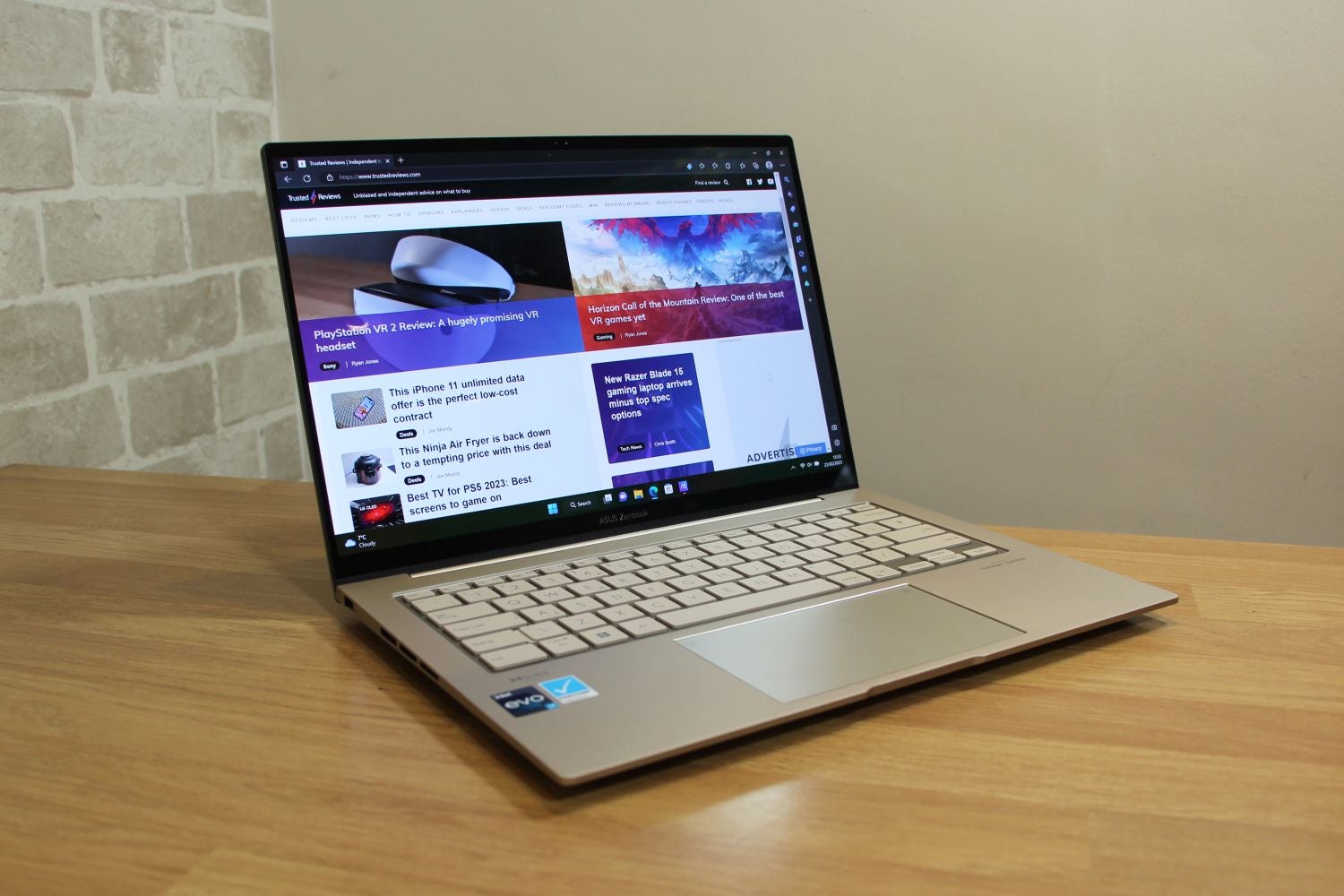Verdict
The Asus Zenbook 14X OLED (2023) gets a lot right. It’s fast, sturdy and has a fantastic screen. Its snappy keyboard and decent connectivity keep things moving. This laptop is cheaper than several rivals too. That said, look elsewhere for boundary-pushing performance or all-day battery life.
Pros
- A bold, colourful OLED display
- Good build quality and keyboard
- Smart, environmentally friendly design
- Powerful Intel Core i7 processor
Cons
- Heavier than many rivals
- Apple’s machines are faster
- Mediocre battery life
Availability
- UKRRP: £1199
- USARRP: $1199
- EuropeRRP: €1399
-
Innovative design:The Sandstone version of this rig uses a Plasma Ceramization process that doesn’t just look good – it banishes fingerprints and scuffs and releases fewer harmful chemicals into the environment. -
Fantastic OLED screen:With a resolution of 2880 x 1800, 120Hz refresh rate and OLED technology, this display does it all. There’s bold and vibrant imagery, with enough accuracy and sharpness to handle creative workloads, too. -
Full-power Intel laptop CPU:Despite the modest internals, Asus crams a full-power Intel Core i7-13700H inside this laptop. It’s far more powerful than the chips inside Windows-based rivals, although the Apple M2 Pro CPU is still faster.
Introduction
Building a laptop to do everything is difficult, but that hasn’t stopped Asus from trying with the Zenbook 14X OLED. In lots of areas, the firm has done a tremendous job.
This notebook’s party piece is its OLED display. But it’s not just about that: you’ll find top-tier Intel processors that aren’t often crammed into laptops this small – not even the best laptops on the market.
It’s heading to retailers soon, and pricing for this model (UX3404VA) looks like it’ll land around $1199/£1199/€1399 – and that’s pretty decent. It’s far less than you’ll pay for any MacBook Pro 13 or 14, and the Dell XPS 13 Plus is more expensive.
The slimmer, lighter but slower Dell XPS 13 and Asus Zenbook S 13 OLED are both usually cheaper than the Zenbook 14X OLED, but not by much.
Design and Keyboard
- Solid build quality and environmentally-friendly lid tech
- Snappy and satisfying keyboard
- Good connectivity but no card reader
The Asus Zenbook 14X OLED is available in two different shades: a deep tone called Inkwell Grey and a lighter offering named Sandstone Beige. Don’t let that last word put you off, the lighter colouring is the more interesting option.
The beige version uses a Plasma Ceramization process that produces a ceramic-like finish. And it does feel like that material – a little textured, but pleasing under the fingers and extremely tactile.
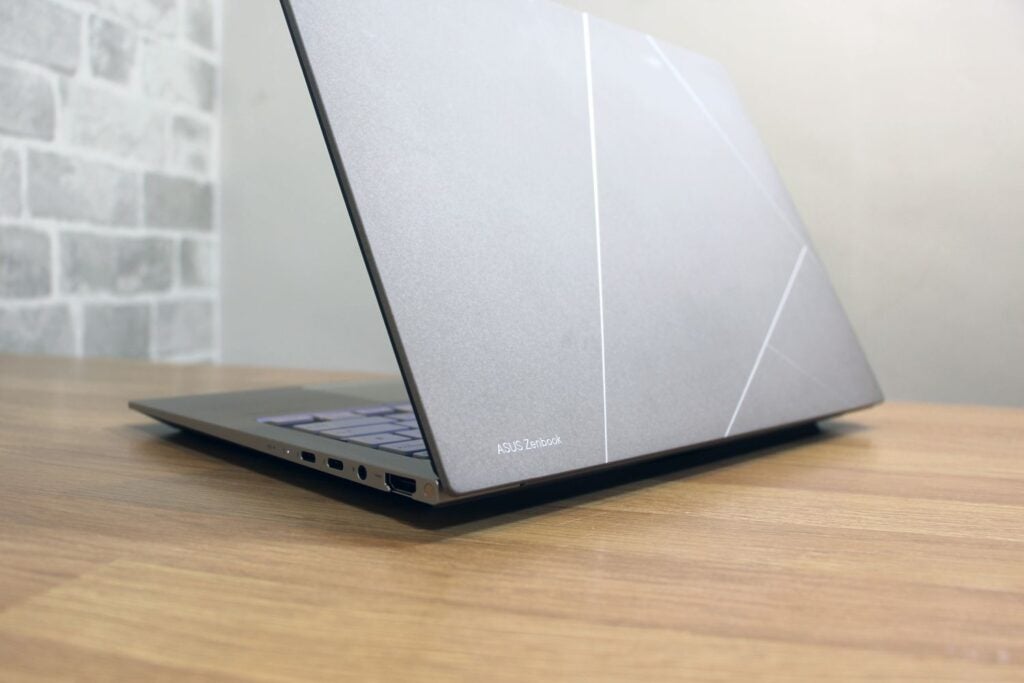
Asus reckons that the coating eschews fingerprints and stays free of scuffs. It also says that its halogen-free process generates lower emissions than other techniques.
It looks and feels fantastic – far better than the dull, fingerprint-magnet grey aluminium on the other version. No matter which one you buy, you’ll get great build quality from the 14X. It’s a sturdy and robust notebook.
At 16.9mm thick and 1.56kg though, the Asus is thicker and heavier than most rivals. Only the MacBook Pro 14 weighs more. It’s no dealbreaker, but worth remembering if you want to pack a light bag.
The 14X deploys two Thunderbolt 4 ports, a sole USB 3.2 Gen 1 connector, an HDMI 2.1 output and audio jack. Inside, you’ll find Wi-Fi 6E and Bluetooth 5.2. Biometrics come from a 1080p Windows Hello webcam and a fingerprint reader in the power button.
The speakers are a little tinny and don’t have much bass – ideal for basic media and background music only.
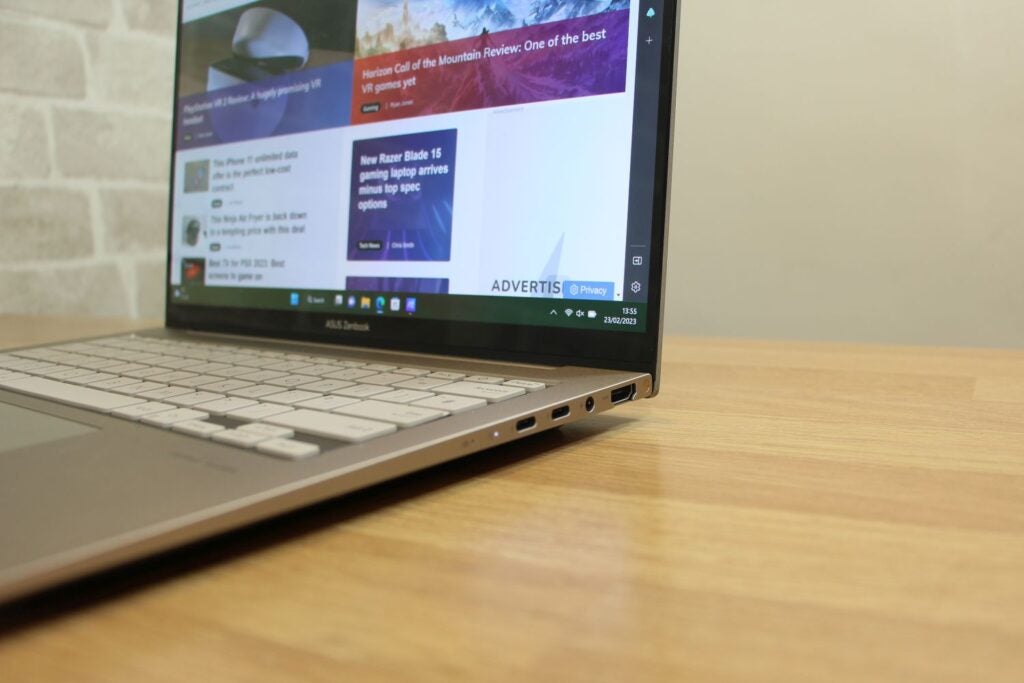
That’s all reasonable. None of the Apple or Dell machines have full-size USB and you won’t find those or Thunderbolt on the AMD-powered Asus Zenbook S either. But, bear in mind, that there’s no card slot on the 14X and you do get SD on the MacBook Pro 14.
The keyboard is soft, quiet and comfortable. Its 1.4mm key travel means everything feels reasonably robust. You get more feedback than on shallower Apple and Dell units, although those are light and pleasing in their own way. It’s an excellent keyboard: easily able to handle busy workloads and good enough to compete with anything else in its class.
There’s no number pad, which is normal on a 14 inch laptop, but you can overlay it on the trackpad. It’s still an awkward solution, though it’s more than most rivals offer. The trackpad is large, smooth and responsive.
Screen
- OLED screen delivers sensational colours
- High resolution and refresh rate ensure a crisp, smooth experience
- Touchscreen makes for a capable companion for creative workloads
The 14.5-inch OLED panel has a 2880 x 1800 resolution, 16:10 aspect ratio and 120Hz refresh rate – a tremendous set of specifications at this price. It’s got a 180-degree hinge for easier sharing, too.
The resolution keeps imagery very crisp and the aspect ratio adds a bit of extra height, like most rivals. The refresh rate goes beyond Dell laptops which means the animation and movement on display are butter-smooth.
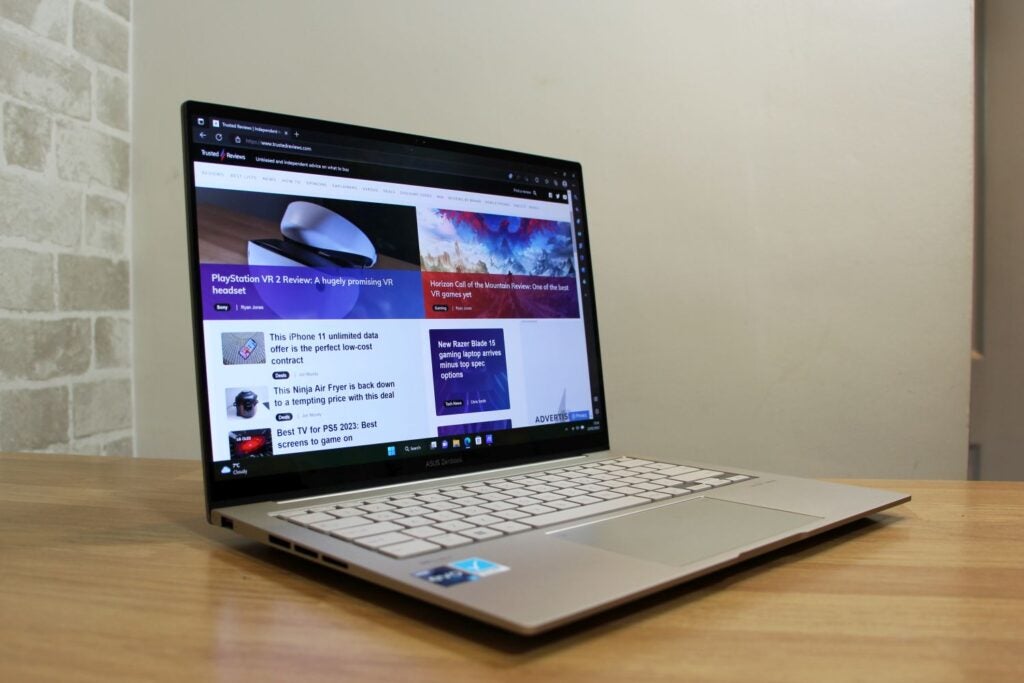
Quality levels are high. OLED means infinite contrast and perfect black levels – which equals incredible depth in darker spots and vibrancy everywhere else. The 0.97 Delta E delivers accurate colours, and the panel renders 100% of the sRGB gamut alongside 97.3% of the DCI-P3 space and 93% of the Adobe RGB range.
Photos, movies and TV shows look brilliant, bright and bold. It’s also got the quality for creative work, including photo and video editing. Some models have Gorilla Glass touchscreens with support for stylus functionality, improving the panel’s creative credentials.
The only downside is the screen’s lack of HDR ability. Asus boasts about the screen’s HDR functionality, but some versions of this screen peak at 600 nits and our display topped out at 412 nits. That’s fine for everyday SDR use indoors and outside, but not good enough to deliver any meaningful HDR benefit.
Still, the 14X’s panel competes well with rival displays. It’s got broader colour ability than either MacBook Pro model and most of the Dell panels. You can pay more to upgrade the XPS machines to 4K OLED displays that’ll outpace the Asus for resolution.
Performance
- As good as it gets in a lightweight Windows machine, unless you buy the Core i9 version
- MacBook Pro 14 still faster
It’s unusual to find a full-power laptop CPU in a machine that’s relatively slim and light, but Asus has done it. This version has an Intel Core i7-13700H that’s got eight Performance cores and a top speed of 5GHz.
The 14X has 16GB of dual-channel DDR5 memory – albeit soldered to the motherboard – and a 1TB SSD with decent read and write speeds of 4,268MB/s and 3,345MB/s.
Most models of the 14X use Intel Iris Xe integrated graphics. In some territories, you’ll find Nvidia GeForce RTX 3050 cores that add mainstream eSports ability to the Asus and some extra creative grunt thanks to Nvidia Studio drivers.
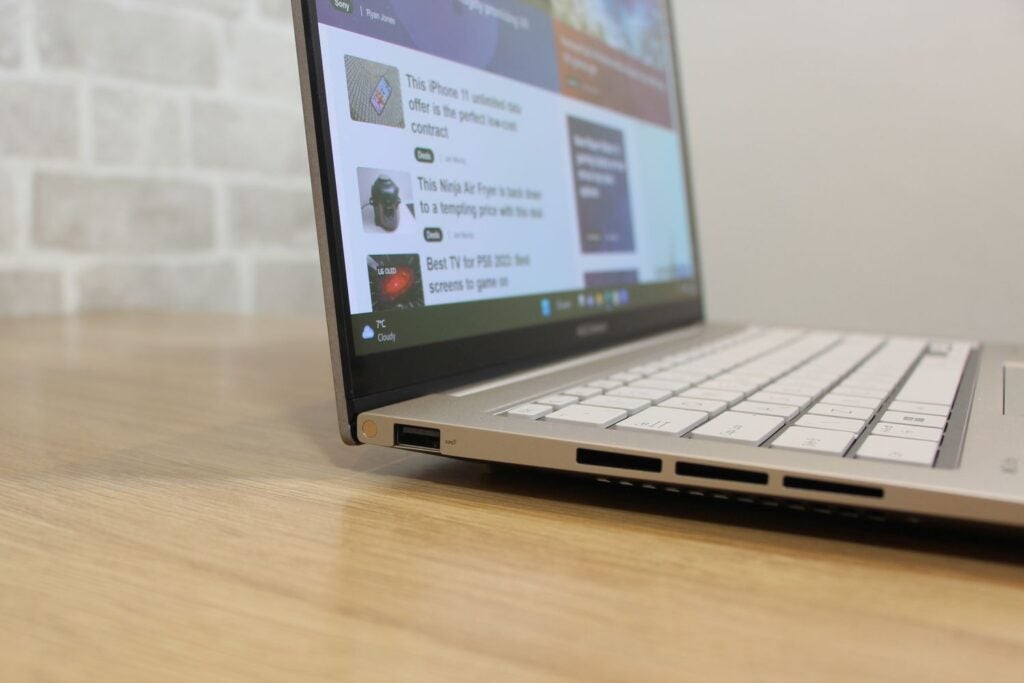
Even without that, there’s solid computing power here. In Geekbench’s single- and multi-core tests the 14X delivered results of 1,599 and 12,024. That latter result is nearly twice as quick as the lower-power Intel chips used inside both XPS models and the modest AMD part inside the Zenbook S 13 OLED. The 14X’s PCMark 10 result of 5785 is about 500 points beyond the i7-1260P in the XPS 13 Plus.
For everyday computing and mainstream computing workloads, that’s great. You’ve easily got enough power to handle any number of browser tabs, all of your comms and media apps as well as some photo-editing and light video work – indeed, for the situations most of us will encounter in everyday life.
If you want more speed from this rig, you’ll have to pay around $1499/£1499/€1599 for the Core i9-13900H version of this notebook. Even then, the difference between the two chips isn’t huge and the boost won’t be significant.
The best way to get a major performance improvement is with a MacBook Pro 14. The M2 Pro CPU inside the 14-inch version hits about 2,500 and 14,000 points in Geekbench, so that’ll have a decent impact on creative workloads. But, Apple’s rigs are more expensive than the Asus.
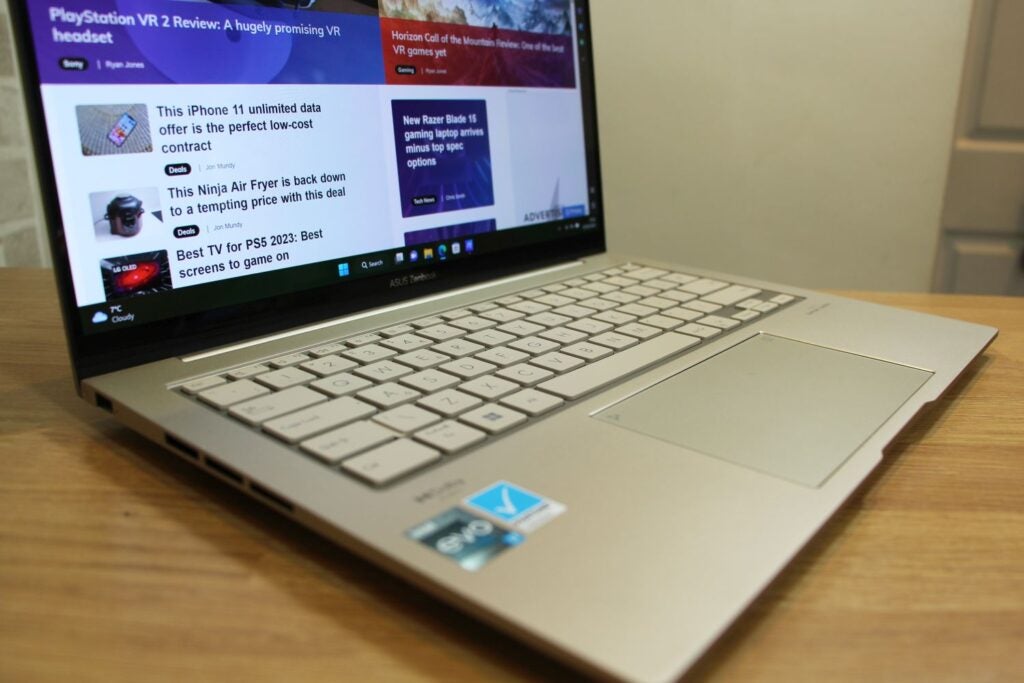
Still, the 14X offers more power than most compact Windows rigs, and the Asus does a decent job with thermals. The only part of the exterior that gets alarmingly hot is the aluminium above the keyboard, and you probably won’t touch that. You can hear fan noise if you push the internals, but it’s consistently quiet and inoffensive, even during tough creative sessions.
Battery Life
The 14X is pretty cool, quiet and powerful, but it’s not particularly long-lasting. In a video benchmark, with the screen at reduced brightness, the Asus lasted for 11 hours and 40 minutes, but that figure declines to about seven hours if you’re pushing through everyday work tasks.
That’s about level with the Dell XPS 13 Plus, but it’s a long way behind Apple’s rigs and the Asus Zenbook S 13 OLED. If you want a machine that guarantees all-day longevity, this isn’t it.
Latest deals
Should you buy it?
You want a compact yet powerful laptop:
This Asus machine brings a lot to the table despite its rather trim size. From a stunning OLED display to strong internals. It’s surprisingly good value too.
You want long-lasting portable performance:
The Zenbook 14X OLED is an impressive laptop but it still can’t match the on-the-go capabilities of Apple’s MacBook Pro, from high-performance when not plugged in to an extra-long battery life.
Final Thoughts
The Asus Zenbook 14X OLED delivers an incredible display and plenty of processing power inside an attractive, robust chassis. Combine that with the decent keyboard and build quality, along with its competitive pricing, then you’ve got a great pick if you want a compact powerhouse for everyday workloads and creative tasks.
That said, Apple’s machines are faster and have better battery life – even if you have to pay for the privilege. If you want something slimmer or lighter still, you can easily sacrifice CPU power and get the job done with several of the 14X’s rivals.
Nevertheless, if you’re on the hunt for a compact, powerful notebook for creative workloads, everyday use and media viewing, this is an excellent option.
How we test
Every laptop we review goes through a series of uniform checks designed to gauge key things including build quality, performance, screen quality and battery life.
These include formal synthetic benchmarks and scripted tests, plus a series of real world checks, such as how well it runs when running everyday apps.
We used as our main laptop for at least a week.
Tested the performance via both benchmark tests and real-world use.
We tested the screen with a colorimeter and real-world use.
We tested the battery with a benchmark test and real-world use.
FAQs
The Space Edition comes with a small external display on the back and an exclusive Zero-G Titanium colour. If this hugely appeals to you, then it could be worth the extra cash. But, there are no major differences.
There are both touch screen and non-touch screen options available for the Zenbook 14X OLED.
Trusted Reviews test data
UK RRP
USA RRP
EU RRP
CPU
Manufacturer
Screen Size
Storage Capacity
Front Camera
Battery
Battery Hours
Size (Dimensions)
Weight
ASIN
Operating System
Release Date
First Reviewed Date
Model Number
Model Variants
Resolution
HDR
Refresh Rate
Ports
GPU
RAM
Connectivity
Colours
Display Technology
Touch Screen
Convertible?
Jargon buster
OLED
Organic Light Emitting Diode is panel technology that allows each individual pixel to produce light rather than relying on a backlight. This enables the screen to accurately display blacks by turning off the pixel, resulting in improved contrast compared to conventional LCD panels.
Refresh Rate
The number of times the screen refreshes itself per second.
Verdict
The Asus Zenbook 14X OLED (2023) gets a lot right. It’s fast, sturdy and has a fantastic screen. Its snappy keyboard and decent connectivity keep things moving. This laptop is cheaper than several rivals too. That said, look elsewhere for boundary-pushing performance or all-day battery life.
Pros
- A bold, colourful OLED display
- Good build quality and keyboard
- Smart, environmentally friendly design
- Powerful Intel Core i7 processor
Cons
- Heavier than many rivals
- Apple’s machines are faster
- Mediocre battery life
Availability
- UKRRP: £1199
- USARRP: $1199
- EuropeRRP: €1399
-
Innovative design:The Sandstone version of this rig uses a Plasma Ceramization process that doesn’t just look good – it banishes fingerprints and scuffs and releases fewer harmful chemicals into the environment. -
Fantastic OLED screen:With a resolution of 2880 x 1800, 120Hz refresh rate and OLED technology, this display does it all. There’s bold and vibrant imagery, with enough accuracy and sharpness to handle creative workloads, too. -
Full-power Intel laptop CPU:Despite the modest internals, Asus crams a full-power Intel Core i7-13700H inside this laptop. It’s far more powerful than the chips inside Windows-based rivals, although the Apple M2 Pro CPU is still faster.
Introduction
Building a laptop to do everything is difficult, but that hasn’t stopped Asus from trying with the Zenbook 14X OLED. In lots of areas, the firm has done a tremendous job.
This notebook’s party piece is its OLED display. But it’s not just about that: you’ll find top-tier Intel processors that aren’t often crammed into laptops this small – not even the best laptops on the market.
It’s heading to retailers soon, and pricing for this model (UX3404VA) looks like it’ll land around $1199/£1199/€1399 – and that’s pretty decent. It’s far less than you’ll pay for any MacBook Pro 13 or 14, and the Dell XPS 13 Plus is more expensive.
The slimmer, lighter but slower Dell XPS 13 and Asus Zenbook S 13 OLED are both usually cheaper than the Zenbook 14X OLED, but not by much.
Design and Keyboard
- Solid build quality and environmentally-friendly lid tech
- Snappy and satisfying keyboard
- Good connectivity but no card reader
The Asus Zenbook 14X OLED is available in two different shades: a deep tone called Inkwell Grey and a lighter offering named Sandstone Beige. Don’t let that last word put you off, the lighter colouring is the more interesting option.
The beige version uses a Plasma Ceramization process that produces a ceramic-like finish. And it does feel like that material – a little textured, but pleasing under the fingers and extremely tactile.

Asus reckons that the coating eschews fingerprints and stays free of scuffs. It also says that its halogen-free process generates lower emissions than other techniques.
It looks and feels fantastic – far better than the dull, fingerprint-magnet grey aluminium on the other version. No matter which one you buy, you’ll get great build quality from the 14X. It’s a sturdy and robust notebook.
At 16.9mm thick and 1.56kg though, the Asus is thicker and heavier than most rivals. Only the MacBook Pro 14 weighs more. It’s no dealbreaker, but worth remembering if you want to pack a light bag.
The 14X deploys two Thunderbolt 4 ports, a sole USB 3.2 Gen 1 connector, an HDMI 2.1 output and audio jack. Inside, you’ll find Wi-Fi 6E and Bluetooth 5.2. Biometrics come from a 1080p Windows Hello webcam and a fingerprint reader in the power button.
The speakers are a little tinny and don’t have much bass – ideal for basic media and background music only.

That’s all reasonable. None of the Apple or Dell machines have full-size USB and you won’t find those or Thunderbolt on the AMD-powered Asus Zenbook S either. But, bear in mind, that there’s no card slot on the 14X and you do get SD on the MacBook Pro 14.
The keyboard is soft, quiet and comfortable. Its 1.4mm key travel means everything feels reasonably robust. You get more feedback than on shallower Apple and Dell units, although those are light and pleasing in their own way. It’s an excellent keyboard: easily able to handle busy workloads and good enough to compete with anything else in its class.
There’s no number pad, which is normal on a 14 inch laptop, but you can overlay it on the trackpad. It’s still an awkward solution, though it’s more than most rivals offer. The trackpad is large, smooth and responsive.
Screen
- OLED screen delivers sensational colours
- High resolution and refresh rate ensure a crisp, smooth experience
- Touchscreen makes for a capable companion for creative workloads
The 14.5-inch OLED panel has a 2880 x 1800 resolution, 16:10 aspect ratio and 120Hz refresh rate – a tremendous set of specifications at this price. It’s got a 180-degree hinge for easier sharing, too.
The resolution keeps imagery very crisp and the aspect ratio adds a bit of extra height, like most rivals. The refresh rate goes beyond Dell laptops which means the animation and movement on display are butter-smooth.

Quality levels are high. OLED means infinite contrast and perfect black levels – which equals incredible depth in darker spots and vibrancy everywhere else. The 0.97 Delta E delivers accurate colours, and the panel renders 100% of the sRGB gamut alongside 97.3% of the DCI-P3 space and 93% of the Adobe RGB range.
Photos, movies and TV shows look brilliant, bright and bold. It’s also got the quality for creative work, including photo and video editing. Some models have Gorilla Glass touchscreens with support for stylus functionality, improving the panel’s creative credentials.
The only downside is the screen’s lack of HDR ability. Asus boasts about the screen’s HDR functionality, but some versions of this screen peak at 600 nits and our display topped out at 412 nits. That’s fine for everyday SDR use indoors and outside, but not good enough to deliver any meaningful HDR benefit.
Still, the 14X’s panel competes well with rival displays. It’s got broader colour ability than either MacBook Pro model and most of the Dell panels. You can pay more to upgrade the XPS machines to 4K OLED displays that’ll outpace the Asus for resolution.
Performance
- As good as it gets in a lightweight Windows machine, unless you buy the Core i9 version
- MacBook Pro 14 still faster
It’s unusual to find a full-power laptop CPU in a machine that’s relatively slim and light, but Asus has done it. This version has an Intel Core i7-13700H that’s got eight Performance cores and a top speed of 5GHz.
The 14X has 16GB of dual-channel DDR5 memory – albeit soldered to the motherboard – and a 1TB SSD with decent read and write speeds of 4,268MB/s and 3,345MB/s.
Most models of the 14X use Intel Iris Xe integrated graphics. In some territories, you’ll find Nvidia GeForce RTX 3050 cores that add mainstream eSports ability to the Asus and some extra creative grunt thanks to Nvidia Studio drivers.

Even without that, there’s solid computing power here. In Geekbench’s single- and multi-core tests the 14X delivered results of 1,599 and 12,024. That latter result is nearly twice as quick as the lower-power Intel chips used inside both XPS models and the modest AMD part inside the Zenbook S 13 OLED. The 14X’s PCMark 10 result of 5785 is about 500 points beyond the i7-1260P in the XPS 13 Plus.
For everyday computing and mainstream computing workloads, that’s great. You’ve easily got enough power to handle any number of browser tabs, all of your comms and media apps as well as some photo-editing and light video work – indeed, for the situations most of us will encounter in everyday life.
If you want more speed from this rig, you’ll have to pay around $1499/£1499/€1599 for the Core i9-13900H version of this notebook. Even then, the difference between the two chips isn’t huge and the boost won’t be significant.
The best way to get a major performance improvement is with a MacBook Pro 14. The M2 Pro CPU inside the 14-inch version hits about 2,500 and 14,000 points in Geekbench, so that’ll have a decent impact on creative workloads. But, Apple’s rigs are more expensive than the Asus.

Still, the 14X offers more power than most compact Windows rigs, and the Asus does a decent job with thermals. The only part of the exterior that gets alarmingly hot is the aluminium above the keyboard, and you probably won’t touch that. You can hear fan noise if you push the internals, but it’s consistently quiet and inoffensive, even during tough creative sessions.
Battery Life
The 14X is pretty cool, quiet and powerful, but it’s not particularly long-lasting. In a video benchmark, with the screen at reduced brightness, the Asus lasted for 11 hours and 40 minutes, but that figure declines to about seven hours if you’re pushing through everyday work tasks.
That’s about level with the Dell XPS 13 Plus, but it’s a long way behind Apple’s rigs and the Asus Zenbook S 13 OLED. If you want a machine that guarantees all-day longevity, this isn’t it.
Latest deals
Should you buy it?
You want a compact yet powerful laptop:
This Asus machine brings a lot to the table despite its rather trim size. From a stunning OLED display to strong internals. It’s surprisingly good value too.
You want long-lasting portable performance:
The Zenbook 14X OLED is an impressive laptop but it still can’t match the on-the-go capabilities of Apple’s MacBook Pro, from high-performance when not plugged in to an extra-long battery life.
Final Thoughts
The Asus Zenbook 14X OLED delivers an incredible display and plenty of processing power inside an attractive, robust chassis. Combine that with the decent keyboard and build quality, along with its competitive pricing, then you’ve got a great pick if you want a compact powerhouse for everyday workloads and creative tasks.
That said, Apple’s machines are faster and have better battery life – even if you have to pay for the privilege. If you want something slimmer or lighter still, you can easily sacrifice CPU power and get the job done with several of the 14X’s rivals.
Nevertheless, if you’re on the hunt for a compact, powerful notebook for creative workloads, everyday use and media viewing, this is an excellent option.
How we test
Every laptop we review goes through a series of uniform checks designed to gauge key things including build quality, performance, screen quality and battery life.
These include formal synthetic benchmarks and scripted tests, plus a series of real world checks, such as how well it runs when running everyday apps.
We used as our main laptop for at least a week.
Tested the performance via both benchmark tests and real-world use.
We tested the screen with a colorimeter and real-world use.
We tested the battery with a benchmark test and real-world use.
FAQs
The Space Edition comes with a small external display on the back and an exclusive Zero-G Titanium colour. If this hugely appeals to you, then it could be worth the extra cash. But, there are no major differences.
There are both touch screen and non-touch screen options available for the Zenbook 14X OLED.
Trusted Reviews test data
UK RRP
USA RRP
EU RRP
CPU
Manufacturer
Screen Size
Storage Capacity
Front Camera
Battery
Battery Hours
Size (Dimensions)
Weight
ASIN
Operating System
Release Date
First Reviewed Date
Model Number
Model Variants
Resolution
HDR
Refresh Rate
Ports
GPU
RAM
Connectivity
Colours
Display Technology
Touch Screen
Convertible?
Jargon buster
OLED
Organic Light Emitting Diode is panel technology that allows each individual pixel to produce light rather than relying on a backlight. This enables the screen to accurately display blacks by turning off the pixel, resulting in improved contrast compared to conventional LCD panels.
Refresh Rate
The number of times the screen refreshes itself per second.


















